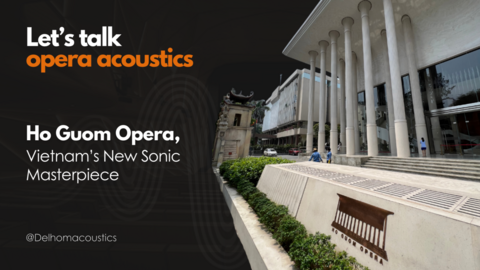Members
Where Architecture Listens: How Ho Guom Opera House Became Vietnam’s Sonic Masterpiece

When the Ho Guom Opera House officially opened its doors to the public in the summer of 2023, it marked a turning point in Vietnam's cultural landscape. Located in the heart of Hanoi’s historic district, a 5-minute walk from the eponymous Hoan Kiem Lake which bestowed its traditional name upon the venue you will discover a blend of heritage, modernity, and above all, a celebration of sound. This article will showcase the incredible behind-the-scenes work that made it possible to create an international performing arts space from design to reality, in just two years.
The Ho Guom Opera House was imagined as both an architectural and acoustic landmark, designed to meet the highest standards for a wide range of performances. Its development brought together a multidisciplinary team, including Vietnamese architects, international theatre and audio specialists, and Delhom Acoustics, one of the leading French acoustic consultancies, with over seven years of active involvement in Vietnam's soundscape.
Designed to seat 900 spectators, the opera house was envisioned to host a very wide range of performances: from symphonies andoperas toamplified concerts and evenmovie premieres. This functional diversity shaped every aspect of the design process. Delhom Acoustics joined from the very start of the concept phase in late 2021, enabling the team to contribute directly to the core architectural decisions such as the building’s height and volume, to ensure performance-driven sound quality throughout the halls.
Crafting a Hybrid Soundscape
Delhom Acoustics’ team, led by Project Director Antoine POMMIER, worked closely with Ho Thieu Tri Architects (HTT), Schuler Shook (theatre consultants), TAIT (stage systems), and Mr. Steven Dubuc a theatre expert hired as a consultant by the client, who first welcomed the exploration of enhanced audio experiences, including the integration of electroacoustic technologies. Building on this vision, Delhom Acoustics introduced the proposal for a hybrid configuration that combined natural room acoustics with adaptive electroacoustic enhancements. This direction ultimately shaped the project’s acoustic identity and led to collaboration with world-renowned Meyer Sound (Constellation integrator), to deliver the incredible results.
Natural early reflections are shaped by a carefully sculpted ceiling and discreet absorption zones. Meanwhile, Meyer Sound’s Constellation system offers real-time adjustability of reverberation and spatial characteristics, allowing the hall to adapt seamlessly to different performance formats.
A Dialogue Between Architecture and Acoustics
The design integrates aesthetic and acoustic elements with careful restraint. Plain and perforated wooden finishes, porous surfaces, bass traps, and concealed layers ensure that sound performance does not interrupt the visual flow. A major component the custom-designed orchestra shell developed with Wenger Corporation was carried out following Delhom Acoustics’ engineering guidance, ensuring a careful balance of acoustic precision and stage functionality, to suit both natural and enhanced audio experiences.
Performance Meets Precision
To achieve such versatility, the Delhom team was guided from the earliest stages onwards, by Delhom Acoustics’ Founder & CEO, Jean-Philippe DELHOMand his +30 years of experience in the field, to sculpt the early acoustic design direction and grasp the global view of the physics behind the hybrid nature of the reflections.
Then, Odeon 3D modelling and ray tracing simulations were used to anticipate how sound would behave in the space. These digital tests informed every detail: material selections, room and surface geometries, as well as sound coverage. With the hybrid system, the reverberation time ranges from 0.8s (suitable for movie premieres and amplified conferences) to over 2.1s (ideal for a symphonic orchestra).
The power of pauses and silences in music is immense, so addressing noise control was also a priority in the design. In a mixed-use and urban setting, it was essential to prevent unwanted sound transferfrom mechanical systems, between rooms, and to/from the exterior.
Delhom Acoustics developed strategies to mitigate these disturbances from the early design phases. The acoustic design of the project includes a future-ready box-in-box concept for the black box located beneath the main theatre, as well as high-performance partitions and carefully engineered HVAC pathways. Vibration risks from mechanical equipment, particularly rooftop units, were mitigated using calibrated steel springs and acoustic pads. In parallel, a detailed analysis of ventilation ductnoise led to the integration of custom silencers and sound traps, achieving the necessary sound attenuation while preserving system efficiency. These measures ensure the essential silence in key areas such as the audience and stage spaces.
Why Acoustics Matter
Acoustics are the invisible architecture of any performance space. For non-experts, it's important to know that sound quality is shaped by every surface and angle in a hall. The texture of a wall, the height of the ceiling, the volume of the space, and the materials beneath your feet all of these factors determine how sound dissipates and how it is perceived. The acoustics of an opera house can help make it famous or infamous, and upon opening, it was clear that a venue like Ho Guom does not simply support music; it lives and breathes it.
A Human Collaboration
The outcome is the work of a tightly knit team. Project leadership came from Antoine Pommier, with conceptual direction by Jean-Philippe Delhom, founder of Delhom Acoustics. Modeling and analysis were carried out by Anh Nguyen, while noise and ventilation strategies were led by Simiao Wu. Additional support came from Delhom’s team members in Paris and Toulouse offices, further enriching the project with the team’s international experience. For a project with such an ambitious timeline, two years from concept to inauguration, a strong sense of teamwork was absolutely key!
What made this project truly distinctive was the alignment between all contributors: the architectural sensitivity of HTT, the staging vision of Schuler Shook, and the sound prowess of Meyer Sound. One of the most memorable moments was Meyer Sound’s first test of the Constellation system a moment of silence followed by pure sound, met with unanimous recognition of the hall’s immersive potential.
Sound as Legacy
Today, the Ho Guom Opera House stands among Vietnam’s most technically sophisticated and acoustically responsive cultural spaces. Since its opening, it has hosted a range of performances such as the Sun Symphony Orchestra from Vietnam and the Evergreen Symphony Orchestra from Taiwan, highlighting its function as a versatile space for all sorts of events in the future.
This venue fills a vital gap in Vietnam’s cultural infrastructure. It allows Vietnamese audiences to experience performances with world-class sound quality and offers local and international artists a space worthy of their craft.
This project stands as a testament to the expertise and care brought by all contributors an enduring achievement shaped not just with precision, but with passion.
“In Ho Guom, every note has a place. And every silence, its meaning.”
This article is the result of a collaborative effort between the Ho Guom Opera team and Delhom Acoustics. It reflects a shared commitment to elevating Vietnam’s cultural landscape through design, sound, and collaboration.


